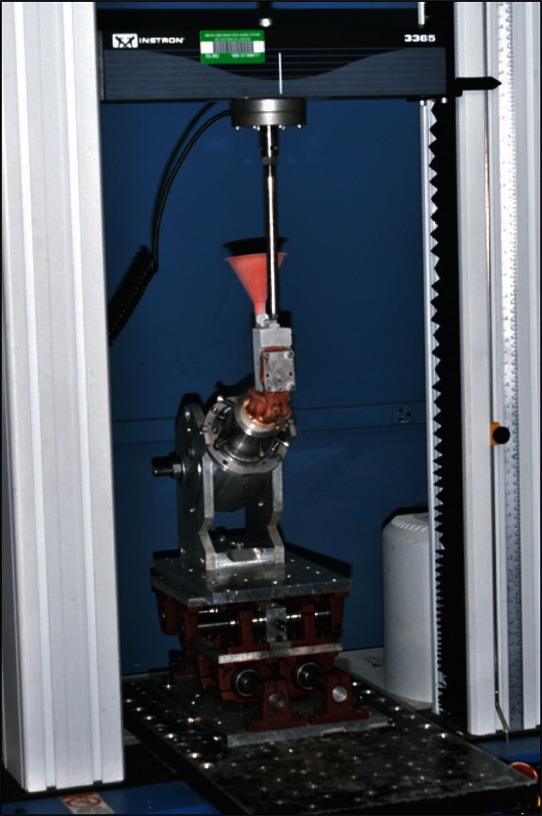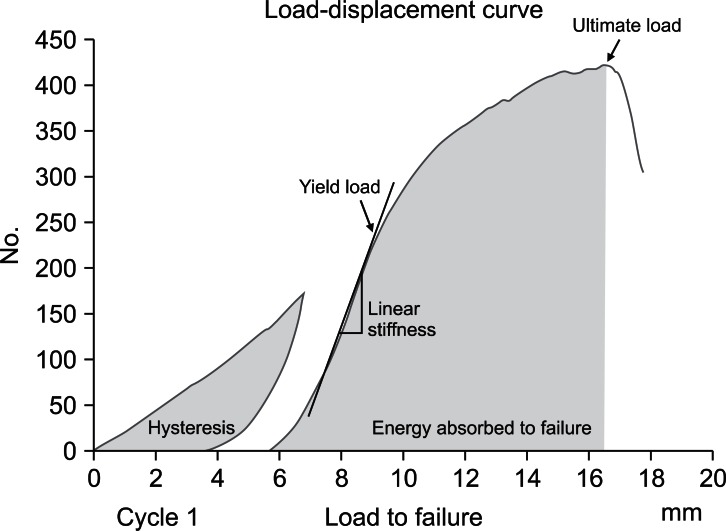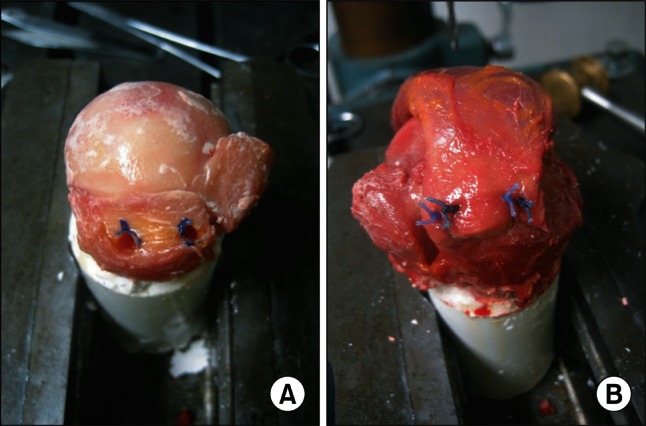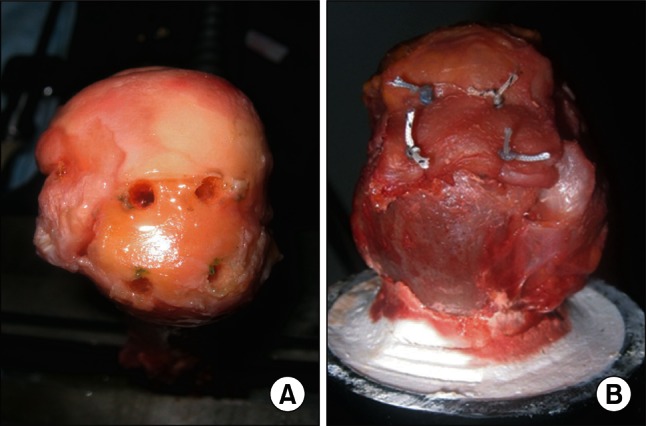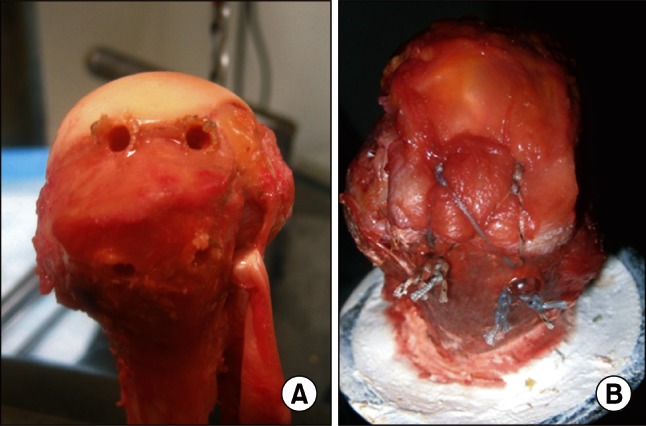Clin Orthop Surg.
2013 Jun;5(2):89-97. 10.4055/cios.2013.5.2.89.
Current Biomechanical Concepts for Rotator Cuff Repair
- Affiliations
-
- 1Orthopaedic Biomechanics Laboratory, Long Beach VA Healthcare System, Long Beach & Department of Orthopaedic Surgery, University of California, Irvine, CA, USA. tqlee@med.va.gov
- KMID: 1705528
- DOI: http://doi.org/10.4055/cios.2013.5.2.89
Abstract
- For the past few decades, the repair of rotator cuff tears has evolved significantly with advances in arthroscopy techniques, suture anchors and instrumentation. From the biomechanical perspective, the focus in arthroscopic repair has been on increasing fixation strength and restoration of the footprint contact characteristics to provide early rehabilitation and improve healing. To accomplish these objectives, various repair strategies and construct configurations have been developed for rotator cuff repair with the understanding that many factors contribute to the structural integrity of the repaired construct. These include repaired rotator cuff tendon-footprint motion, increased tendon-footprint contact area and pressure, and tissue quality of tendon and bone. In addition, the healing response may be compromised by intrinsic factors such as decreased vascularity, hypoxia, and fibrocartilaginous changes or aforementioned extrinsic compression factors. Furthermore, it is well documented that torn rotator cuff muscles have a tendency to atrophy and become subject to fatty infiltration which may affect the longevity of the repair. Despite all the aforementioned factors, initial fixation strength is an essential consideration in optimizing rotator cuff repair. Therefore, numerous biomechanical studies have focused on elucidating the strongest devices, knots, and repair configurations to improve contact characteristics for rotator cuff repair. In this review, the biomechanical concepts behind current rotator cuff repair techniques will be reviewed and discussed.
MeSH Terms
Figure
Reference
-
1. Apreleva M, Ozbaydar M, Fitzgibbons PG, Warner JJ. Rotator cuff tears: the effect of the reconstruction method on three-dimensional repair site area. Arthroscopy. 2002; 18(5):519–526. PMID: 11987064.2. Cofield RH. Rotator cuff disease of the shoulder. J Bone Joint Surg Am. 1985; 67(6):974–979. PMID: 4019548.
Article3. Hattrup SJ. Rotator cuff repair: relevance of patient age. J Shoulder Elbow Surg. 1995; 4(2):95–100. PMID: 7600171.
Article4. Morrison DS, Frogameni AD, Woodworth P. Non-operative treatment of subacromial impingement syndrome. J Bone Joint Surg Am. 1997; 79(5):732–737. PMID: 9160946.
Article5. Grant JC, Smith CG. Aging incidence of rupture of the supraspinatus tendon. Anat Rec. 1948; 100(4):666.6. Keyes EL. Observations on rupture of the supraspinatus tendon: based upon a study of seventy-three cadavers. Ann Surg. 1933; 97(6):849–856. PMID: 17866987.
Article7. Milgrom C, Schaffler M, Gilbert S, van Holsbeeck M. Rotator-cuff changes in asymptomatic adults: the effect of age, hand dominance and gender. J Bone Joint Surg Br. 1995; 77(2):296–298. PMID: 7706351.
Article8. Sher JS, Uribe JW, Posada A, Murphy BJ, Zlatkin MB. Abnormal findings on magnetic resonance images of asymptomatic shoulders. J Bone Joint Surg Am. 1995; 77(1):10–15. PMID: 7822341.
Article9. Luopajärvi T, Kuorinka I, Virolainen M, Holmberg M. Prevalence of tenosynovitis and other injuries of the upper extremities in repetitive work. Scand J Work Environ Health. 1979; 5(suppl 3):48–55. PMID: 545693.10. Welch LS, Hunting KL, Kellogg J. Work-related musculoskeletal symptoms among sheet metal workers. Am J Ind Med. 1995; 27(6):783–791. PMID: 7645573.
Article11. Bennett WF. Arthroscopic repair of massive rotator cuff tears: a prospective cohort with 2- to 4-year follow-up. Arthroscopy. 2003; 19(4):380–390. PMID: 12671621.
Article12. Bennett WF. Arthroscopic repair of full-thickness supraspinatus tears (small-to-medium): a prospective study with 2- to 4-year follow-up. Arthroscopy. 2003; 19(3):249–256. PMID: 12627148.
Article13. Boszotta H, Prunner K. Arthroscopically assisted rotator cuff repair. Arthroscopy. 2004; 20(6):620–626. PMID: 15241314.
Article14. Burkhart SS, Danaceau SM, Pearce CE Jr. Arthroscopic rotator cuff repair: analysis of results by tear size and by repair technique-margin convergence versus direct tendon-to-bone repair. Arthroscopy. 2001; 17(9):905–912. PMID: 11694920.15. Gartsman GM, Khan M, Hammerman SM. Arthroscopic repair of full-thickness tears of the rotator cuff. J Bone Joint Surg Am. 1998; 80(6):832–840. PMID: 9655101.
Article16. Jones CK, Savoie FH 3rd. Arthroscopic repair of large and massive rotator cuff tears. Arthroscopy. 2003; 19(6):564–571. PMID: 12861193.
Article17. Kim SH, Ha KI, Park JH, Kang JS, Oh SK, Oh I. Arthroscopic versus mini-open salvage repair of the rotator cuff tear: outcome analysis at 2 to 6 years' follow-up. Arthroscopy. 2003; 19(7):746–754. PMID: 12966383.
Article18. Murray TF Jr, Lajtai G, Mileski RM, Snyder SJ. Arthroscopic repair of medium to large full-thickness rotator cuff tears: outcome at 2- to 6-year follow-up. J Shoulder Elbow Surg. 2002; 11(1):19–24. PMID: 11845144.
Article19. Severud EL, Ruotolo C, Abbott DD, Nottage WM. All-arthroscopic versus mini-open rotator cuff repair: a long-term retrospective outcome comparison. Arthroscopy. 2003; 19(3):234–238. PMID: 12627146.
Article20. Wilson F, Hinov V, Adams G. Arthroscopic repair of full-thickness tears of the rotator cuff: 2- to 14-year follow-up. Arthroscopy. 2002; 18(2):136–144. PMID: 11830806.21. Wolf EM, Pennington WT, Agrawal V. Arthroscopic rotator cuff repair: 4- to 10-year results. Arthroscopy. 2004; 20(1):5–12. PMID: 14716273.
Article22. Galatz LM, Ball CM, Teefey SA, Middleton WD, Yamaguchi K. The outcome and repair integrity of completely arthroscopically repaired large and massive rotator cuff tears. J Bone Joint Surg Am. 2004; 86(2):219–224. PMID: 14960664.
Article23. Harryman DT 2nd, Mack LA, Wang KY, Jackins SE, Richardson ML, Matsen FA 3rd. Repairs of the rotator cuff: correlation of functional results with integrity of the cuff. J Bone Joint Surg Am. 1991; 73(7):982–989. PMID: 1874784.
Article24. Jost B, Pfirrmann CW, Gerber C, Switzerland Z. Clinical outcome after structural failure of rotator cuff repairs. J Bone Joint Surg Am. 2000; 82(3):304–314. PMID: 10724223.
Article25. Gazielly DF, Gleyze P, Montagnon C. Functional and anatomical results after rotator cuff repair. Clin Orthop Relat Res. 1994; (304):43–53. PMID: 8020233.
Article26. Goutallier D, Postel JM, Gleyze P, Leguilloux P, Van Driessche S. Influence of cuff muscle fatty degeneration on anatomic and functional outcomes after simple suture of full-thickness tears. J Shoulder Elbow Surg. 2003; 12(6):550–554. PMID: 14671517.
Article27. Gerber C, Fuchs B, Hodler J. The results of repair of massive tears of the rotator cuff. J Bone Joint Surg Am. 2000; 82(4):505–515. PMID: 10761941.
Article28. Ahmad CS, Stewart AM, Izquierdo R, Bigliani LU. Tendon-bone interface motion in transosseous suture and suture anchor rotator cuff repair techniques. Am J Sports Med. 2005; 33(11):1667–1671. PMID: 16093532.
Article29. Park MC, ElAttrache NS, Tibone JE, Ahmad CS, Jun BJ, Lee TQ. Part I: Footprint contact characteristics for a transosseous-equivalent rotator cuff repair technique compared with a double-row repair technique. J Shoulder Elbow Surg. 2007; 16(4):461–468. PMID: 17321161.
Article30. Park MC, Tibone JE, ElAttrache NS, Ahmad CS, Jun BJ, Lee TQ. Part II: Biomechanical assessment for a footprint-restoring transosseous-equivalent rotator cuff repair technique compared with a double-row repair technique. J Shoulder Elbow Surg. 2007; 16(4):469–476. PMID: 17321158.
Article31. Carpenter JE, Flanagan CL, Thomopoulos S, Yian EH, Soslowsky LJ. The effects of overuse combined with intrinsic or extrinsic alterations in an animal model of rotator cuff tendinosis. Am J Sports Med. 1998; 26(6):801–807. PMID: 9850782.32. Soslowsky LJ, Thomopoulos S, Esmail A, et al. Rotator cuff tendinosis in an animal model: role of extrinsic and overuse factors. Ann Biomed Eng. 2002; 30(8):1057–1063. PMID: 12449766.
Article33. Kuhn JE, Bey MJ, Huston LJ, Blasier RB, Soslowsky LJ. Ligamentous restraints to external rotation of the humerus in the late-cocking phase of throwing: a cadaveric biomechanical investigation. Am J Sports Med. 2000; 28(2):200–205. PMID: 10750996.34. Thomopoulos S, Williams GR, Soslowsky LJ. Tendon to bone healing: differences in biomechanical, structural, and compositional properties due to a range of activity levels. J Biomech Eng. 2003; 125(1):106–113. PMID: 12661203.
Article35. Uhthoff HK, Matsumoto F, Trudel G, Himori K. Early reattachment does not reverse atrophy and fat accumulation of the supraspinatus: an experimental study in rabbits. J Orthop Res. 2003; 21(3):386–392. PMID: 12706009.36. Uhthoff HK, Sano H, Trudel G, Ishii H. Early reactions after reimplantation of the tendon of supraspinatus into bone: a study in rabbits. J Bone Joint Surg Br. 2000; 82(7):1072–1076. PMID: 11041604.37. Caldwell GL, Warner JP, Miller MD, Boardman D, Towers J, Debski R. Strength of fixation with transosseous sutures in rotator cuff repair. J Bone Joint Surg Am. 1997; 79(7):1064–1068. PMID: 9234883.
Article38. Craft DV, Moseley JB, Cawley PW, Noble PC. Fixation strength of rotator cuff repairs with suture anchors and the transosseous suture technique. J Shoulder Elbow Surg. 1996; 5(1):32–40. PMID: 8919440.39. Demirhan M, Atalar AC, Kilicoglu O. Primary fixation strength of rotator cuff repair techniques: a comparative study. Arthroscopy. 2003; 19(6):572–576. PMID: 12861194.
Article40. Goradia VK, Mullen DJ, Boucher HR, Parks BG, O'Donnell JB. Cyclic loading of rotator cuff repairs: a comparison of bioabsorbable tacks with metal suture anchors and transosseous sutures. Arthroscopy. 2001; 17(4):360–364. PMID: 11288006.41. Koh JL, Szomor Z, Murrell GA, Warren RF. Supplementation of rotator cuff repair with a bioresorbable scaffold. Am J Sports Med. 2002; 30(3):410–413. PMID: 12016083.
Article42. Lee S, Mahar A, Bynum K, Pedowitz R. Biomechanical comparison of bioabsorbable sutureless screw anchor versus suture anchor fixation for rotator cuff repair. Arthroscopy. 2005; 21(1):43–47. PMID: 15650665.
Article43. Ma CB, MacGillivray JD, Clabeaux J, Lee S, Otis JC. Biomechanical evaluation of arthroscopic rotator cuff stitches. J Bone Joint Surg Am. 2004; 86(6):1211–1216. PMID: 15173294.
Article44. Reed SC, Glossop N, Ogilvie-Harris DJ. Full-thickness rotator cuff tears: a biomechanical comparison of suture versus bone anchor techniques. Am J Sports Med. 1996; 24(1):46–48. PMID: 8638752.45. Schneeberger AG, von Roll A, Kalberer F, Jacob HA, Gerber C. Mechanical strength of arthroscopic rotator cuff repair techniques: an in vitro study. J Bone Joint Surg Am. 2002; 84(12):2152–2160. PMID: 12473702.46. Waltrip RL, Zheng N, Dugas JR, Andrews JR. Rotator cuff repair: a biomechanical comparison of three techniques. Am J Sports Med. 2003; 31(4):493–497. PMID: 12860534.47. Fealy S, Kingham TP, Altchek DW. Mini-open rotator cuff repair using a two-row fixation technique: outcomes analysis in patients with small, moderate, and large rotator cuff tears. Arthroscopy. 2002; 18(6):665–670. PMID: 12098132.48. Lo IK, Burkhart SS. Double-row arthroscopic rotator cuff repair: re-establishing the footprint of the rotator cuff. Arthroscopy. 2003; 19(9):1035–1042. PMID: 14608329.
Article49. Kim DH, Elattrache NS, Tibone JE, et al. Biomechanical comparison of a single-row versus double-row suture anchor technique for rotator cuff repair. Am J Sports Med. 2006; 34(3):407–414. PMID: 16282581.
Article50. Park MC, Cadet ER, Levine WN, Bigliani LU, Ahmad CS. Tendon-to-bone pressure distributions at a repaired rotator cuff footprint using transosseous suture and suture anchor fixation techniques. Am J Sports Med. 2005; 33(8):1154–1159. PMID: 16000662.
Article51. Behrens SB, Bruce B, Zonno AJ, Paller D, Green A. Initial fixation strength of transosseous-equivalent suture bridge rotator cuff repair is comparable with transosseous repair. Am J Sports Med. 2012; 40(1):133–140. PMID: 22088578.
Article52. Busfield BT, Glousman RE, McGarry MH, Tibone JE, Lee TQ. A biomechanical comparison of 2 technical variations of double-row rotator cuff fixation: the importance of medial row knots. Am J Sports Med. 2008; 36(5):901–906. PMID: 18326033.53. Chhabra A, Goradia VK, Francke EI, et al. In vitro analysis of rotator cuff repairs: a comparison of arthroscopically inserted tacks or anchors with open transosseous repairs. Arthroscopy. 2005; 21(3):323–327. PMID: 15756187.
Article54. Ellman H. Arthroscopic subacromial decompression: a preliminary report. Orthop Trans. 1985; 9:49.55. Bicknell RT, Harwood C, Ferreira L, et al. Cyclic loading of rotator cuff repairs: an in vitro biomechanical comparison of bioabsorbable tacks with transosseous sutures. Arthroscopy. 2005; 21(7):875–880. PMID: 16012502.
Article56. Tuoheti Y, Itoi E, Yamamoto N, et al. Contact area, contact pressure, and pressure patterns of the tendon-bone interface after rotator cuff repair. Am J Sports Med. 2005; 33(12):1869–1874. PMID: 16157853.
Article57. Yu J, McGarry MH, Lee YS, Duong LV, Lee TQ. Biomechanical effects of supraspinatus repair on the glenohumeral joint. J Shoulder Elbow Surg. 2005; 14(1 Suppl S):65S–71S. PMID: 15726089.
Article58. Smith CD, Alexander S, Hill AM, et al. A biomechanical comparison of single and double-row fixation in arthroscopic rotator cuff repair. J Bone Joint Surg Am. 2006; 88(11):2425–2431. PMID: 17079400.
Article59. Snyder SJ. Single vs. double row suture anchor fixation rotator cuff repair. American Orthopaedic Society of Sports Medicine Specialty Day at the 75th Annual Meeting of the American Academy of Orthopaedic Surgeons. 2007 Mar 8; San Francisco, CA, USA.60. Domb BG, Glousman RE, Brooks A, Hansen M, Lee TQ, ElAttrache NS. High-tension double-row footprint repair compared with reduced-tension single-row repair for massive rotator cuff tears. J Bone Joint Surg Am. 2008; 90(Suppl 4):35–39. PMID: 18984716.
Article61. Ma CB, Comerford L, Wilson J, Puttlitz CM. Biomechanical evaluation of arthroscopic rotator cuff repairs: double-row compared with single-row fixation. J Bone Joint Surg Am. 2006; 88(2):403–410. PMID: 16452754.62. Meier SW, Meier JD. The effect of double-row fixation on initial repair strength in rotator cuff repair: a biomechanical study. Arthroscopy. 2006; 22(11):1168–1173. PMID: 17084292.
Article63. Meier SW, Meier JD. Rotator cuff repair: the effect of double-row fixation on three-dimensional repair site. J Shoulder Elbow Surg. 2006; 15(6):691–696. PMID: 17126241.
Article64. Sano H, Yamashita T, Wakabayashi I, Itoi E. Stress distribution in the supraspinatus tendon after tendon repair: suture anchors versus transosseous suture fixation. Am J Sports Med. 2007; 35(4):542–546. PMID: 17218657.65. Park MC, Elattrache NS, Ahmad CS, Tibone JE. "Transosseous-equivalent" rotator cuff repair technique. Arthroscopy. 2006; 22(12):1360.e1–1360.e5. PMID: 17157738.
Article66. Gates JJ, Gilliland J, McGarry MH, et al. Influence of distinct anatomic subregions of the supraspinatus on humeral rotation. J Orthop Res. 2010; 28(1):12–17. PMID: 19621422.
Article67. Ihashi K, Matsushita N, Yagi R, Handa Y. Rotational action of the supraspinatus muscle on the shoulder joint. J Electromyogr Kinesiol. 1998; 8(5):337–346. PMID: 9785254.
Article68. Park MC, Jun BJ, Park CJ, Ahmad CS, ElAttrache NS, Lee TQ. The biomechanical effects of dynamic external rotation on rotator cuff repair compared to testing with the humerus fixed. Am J Sports Med. 2007; 35(11):1931–1939. PMID: 17641102.
Article
- Full Text Links
- Actions
-
Cited
- CITED
-
- Close
- Share
- Similar articles
-
- Revisional Rotator Cuff Repair
- Biomechanical Test for Repair Technique of Full-thickness Rotator Cuff Tear
- Surgical Options for Failed Rotator Cuff Repair, except Arthroplasty: Review of Current Methods
- Current Concepts and Recent Trends in Arthroscopic Treatment of Large to Massive Rotator Cuff Tears: A Review
- New Retear Pattern after Rotator Cuff Repair at Previous Intact Portion of Rotator Cuff

